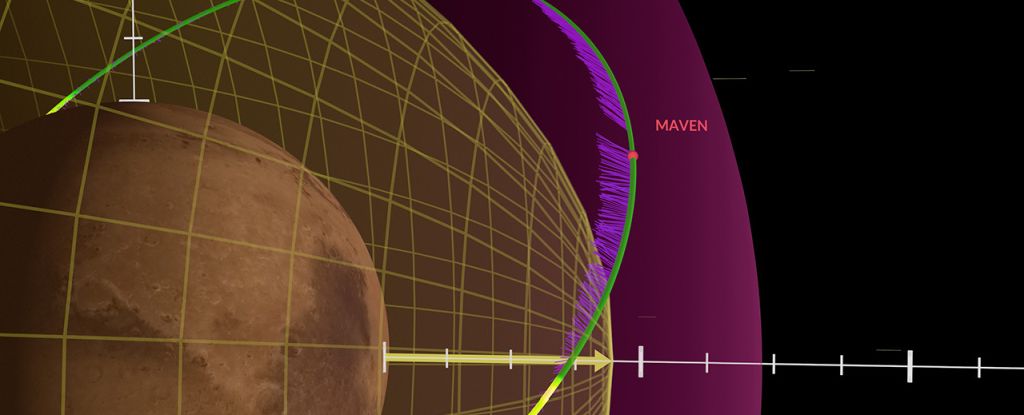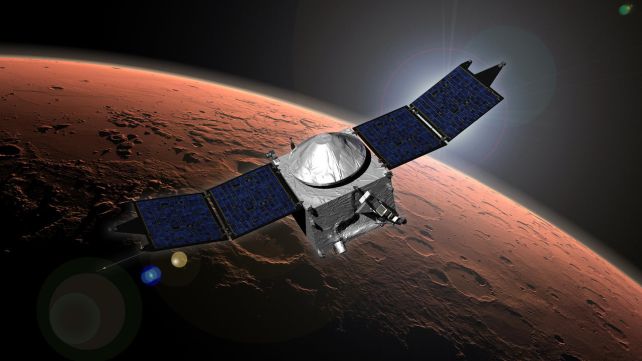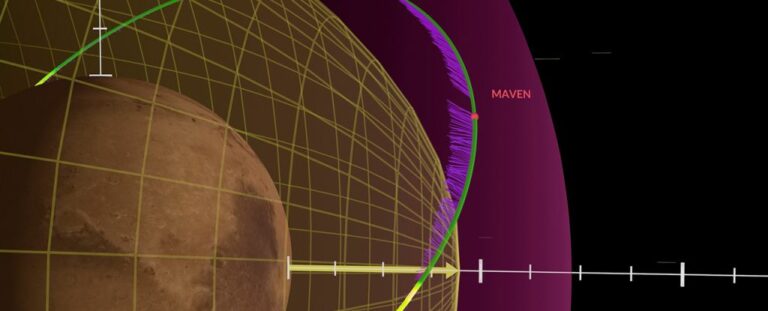A ‘Void’ Speeding Through the Solar System Caused the Detonation of Mars’ Atmosphere.
A vacuum created by an exceptionally potent solar wind gust triggered a remarkable expansion of Mars’ atmosphere. On December 26, 2022, as the MAVEN spacecraft observed a sudden and significant reduction in solar particles during the wind’s passage, an unusual and astonishing transformation occurred in the Martian atmosphere. The planet’s magnetosphere and ionosphere underwent a rapid expansion, stretching over thousands of kilometers and more than tripling in size.

The last occurrence of such a phenomenon was in 1999 when a sudden decline in solar wind caused Earth’s magnetosphere to expand, increasing its volume by a factor of 100.
This rare event offers a unique opportunity to observe how Mars reacts to abrupt changes in the conditions of the Solar System. It may provide valuable insights into the interactions between Solar System-like planets and their environments around different types of stars.
Moreover, this type of measurement can only be conducted in situ, underscoring the importance of deploying spacecraft in orbit around diverse worlds within our Solar System to observe and understand their interactions with the surrounding celestial environment.

“When we initially examined the data and observed the drastic decrease in the solar wind, it seemed almost incredulous,” commented astronomer Jasper Halekas from the University of Iowa, who is also the lead author of a new study on the event. “In response, we established a working group to investigate the occurrence, and during this analysis, we uncovered a wealth of remarkable findings.”
The solar wind maintains a relatively constant presence in the Solar System, enveloping all the planets. It constitutes a continuous stream of particles emanating from the Sun, radiating in all directions and creating ambient pressure throughout the Solar System. This pressure diminishes with distance and eventually diminishes at a boundary known as the heliopause.
However, the intensity of this solar wind can vary with solar activity. For example, regions of weakened solar magnetic fields on the Sun’s surface can release a more potent solar wind, bombarding the system with increased and stronger solar particles.
The solar wind that swept past Mars on December 26, 2022, presented a distinct characteristic. It comprised two solar winds—an initial slower one that merged with and was engulfed by a faster wind approaching from behind, forming a unified super wind.
MAVEN registered the elevated particle density resulting from this dual solar wind encounter. Subsequently, after the wind had passed, the orbiting observatory detected a noteworthy decrease in particle density—an unusual void characterized by an exceptionally weak and low-density solar wind, accompanied by a reduction in solar wind pressure. The particle density plummeted by a factor of 100, and the pressure decreased by a factor of 10.
With the diminishing pressure in its vicinity, the Martian atmosphere underwent a notable reaction. Typically, the solar wind exerts pressure on a planet’s magnetosphere, a phenomenon largely generated by the internal tumult of molten material on planets like Earth. Although Mars lacks a global magnetosphere, it possesses what is termed an induced magnetic field, formed as magnetic fields within the solar wind become entangled in Mars’ ionosphere.
In response to the reduced pressure, the ionosphere and the induced magnetic field expanded extensively, akin to the Martian atmosphere loosening a constrictive corset. The induced magnetic field lost its magnetization, and the region between it and the solar wind—the bow shock—experienced a considerable reduction in its usual turbulence.
According to the researchers, this observation could provide valuable insights into the mechanisms of atmospheric loss on Mars and analogous planets throughout the galaxy. It may contribute essential pieces to the puzzle of determining the factors that render a planet habitable.
“We are truly witnessing how Mars reacts when the solar wind is effectively diminished,” remarked Halekas. “This study serves as an exceptional outlier, offering insights into what Mars would be like if it orbited a less ‘windy’ star.”
The team is presenting its findings at the American Geophysical Union Fall Meeting 2023.
This article is republished from ScienceAlert under a Creative Commons license. Read the original article.
Do not forget to share your opinion with us to provide you with the best posts !




0 Comments